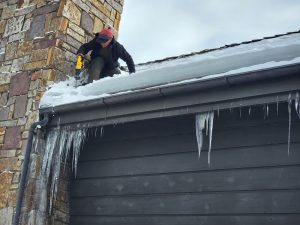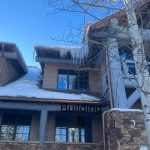Ice Dams: Unveiling the Hidden Dangers to Your Roof
When it comes to your roof, damages that you don’t notice are sometimes the most costly ones. One often-overlooked hazard, particularly prevalent in colder climates like Colorado, is the formation of ice dams on roofs. Beyond being a seasonal inconvenience, this formation poses a serious threat that can lead to costly roof repairs if not promptly addressed.
The Science Behind Ice Dam Formation

Beware of ice dams—a hidden threat to your roof’s stability, requiring prompt roofing and roof repair attention
Understanding the science behind ice dam formation reveals a fascinating interplay between household heat dynamics and winter weather patterns. The cycle begins with uneven heating across the roof surface, a result of escaping warmth from the home. This escaping heat, often due to inadequate insulation or ventilation in the attic space, creates a thermal gradient on the roof with varying temperatures.
As snow blankets the roof, the section directly above the warmer area begins to melt, forming water that travels down the slope. Upon reaching the colder perimeter where the roof’s temperature drops below freezing, this water refreezes, gradually accumulating into the problematic ice dam.
Unraveling the Problems Caused by Ice Dams
While ice dams may appear picturesque against a winter landscape, they introduce a multitude of complications for homeowners. The immediate concern is the potential for water to pool and infiltrate the roofing system, finding its way into your home. This moisture not only causes superficial damage but also compromises insulation, fostering mold growth and posing health risks. Externally, the freeze-thaw cycle intrinsic to ice dams may also loosen shingles, exposing the roof to water damage and weakening its defenses against the elements. Gutters and downspouts also end up bearing the weight of the ice. This stress can lead to detachment, becoming not just a repair concern but also a safety hazard
Preventive Measures to Avert Ice Dam Formation
The journey to prevent ice dams is by taking a proactive step toward preserving the integrity of your roof and overall, your home. One key lies in maintaining a uniform temperature across your roof’s surface, focusing on insulation and ventilation within the attic space. Enhancing attic insulation acts as a crucial barrier against thermal transfer, effectively reducing the uneven melting and refreezing of snow.
Heat tape on roofs serves as a proactive approach to ice dams. Ice dams inevitably develop, and there is no foolproof way to prevent their formation. The implementation of a heat cable assists in creating a void at the base of the ice, helping to prevent in the accumulation of water pools. However, it’s important to note that even with the heat tape in place, ice dams can still occur in the areas between the heated sections
Maintaining clear gutters and downspouts is also important, ensuring unblocked water flow off the roof and minimizing the potential for ice accumulation at the eaves.
Embracing a regimen of regular roof maintenance and inspection emerges as a preventative measure of the utmost importance. This proactive approach anticipates ice dam formation and fortifies your home’s defense, ensuring resilience against the intricate challenges posed by these icy intruders. Contact us today at Horn Brothers Roofing. We understand Colorado’s winter climate and can help you address the issues of our unpredictable weather patterns.




You must be logged in to post a comment.